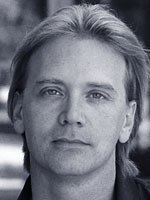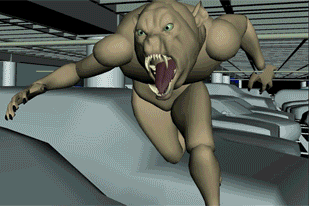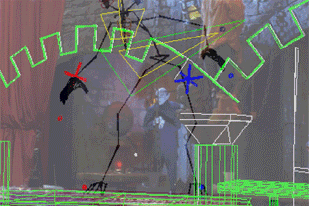Henry Turner heads out into the woods to uncover what haunting effects Wes Cravens Cursed beholds.

One of the main problems in monster movies has always been monster suits. Take werewolves. Men have been transforming into wolves ever since the days when Henry Hull stalked London, in Werewolf of London. But it was not until Joe Dantes The Howling and John Landis American Werewolf in London that efforts were made to have the werewolf bear actual resemblance to a quadruped. Until then, the werewolf, whether played by Hull, Lon Chaney Jr., Oliver Reed or even Michael Landon, was always a hairy man, a sort of Mr. Hyde with a few wolf-like characteristics, skipping around on the balls of its feet. And even the work of Dante and Landis was limited to few long shots of somewhat stiff animatronic creatures or miniatures. The real curse of the werewolf has always been the legs the human legs that could not be made to appear with canine angularity.
Now Wes Craven and Spencer Cook have changed all that with their fun and scary rollercoaster ride.
Cravens new film Cursed features what are without doubt the most realistic werewolves ever put on screen. Created from three main sources a costumed actor, animatronics and a digital werewolf, the filmmakers no longer had to resort to shadowy suggestion to put across images of a truly hybrid creature as equally wolf-like as human. Spencer Cook, Sony Imageworks animation supervisor on Cursed, explains: The digital component was to replicate Rick Bakers werewolf costume, to make a digital copy of it. We modified it to some extent, because in the digital shots, you see the full werewolf from head to toe, as opposed to the performer in the costume, which you see only in close-up or from the waist up. And that was mainly because of the design of the werewolf with the canine legs the back legs of a dog, with the foot elongated, so the werewolf is walking on the balls of its feet, the heel much higher and the tibia bone much shorter. We modified the lower half of the body somewhat so it looked more natural. And then, of course, we animated it walking and running in an appropriate way as well. Its a much different kind of walk than a person could do.

Stages of Transformation
Cook came onto the project after animator Jeremy Cantor had done the preliminary work. Jeremy did the initial rig of the werewolf models, Cook explains. Basically, the process was that Rick Bakers studio designed the werewolf based on Wess ideas, and input from the art director as well. A scale maquette was sculpted, and then a costume was made from that design. The animatronics were created mostly for the facial part of the costume, to move the lips, eyes, ears and wrinkle the skin. The costume was worn by a performer, and his facial expressions were the animatronic aspect of it.
Cook adds that the model department at Sony designed and built the surface textures for the animation model, with all the muscle shapes and surface details. Once scanned and digitized, the animation could begin. The werewolf gets rigged with a series of joints that allows us animators to select certain controls and bend the arms, bend the leg, turn the head and do all the stuff we need to do to create a performance with it.
Naturally, the final rendered image with fur, muscular details, deformations and lighting, takes hours per frame to complete. Hence during the animation stage, Cook worked with a lower-resolution version of the werewolf, which allowed him to see the movement of the creature in realtime. When we move the limbs, there is not a big delay the analogy I use is that were manipulating it like a stop-motion puppet. I come from a stop-motion background and to me it seems like the same thing theres a jointed skeleton inside this thing and it holds whatever position you put it in, and thats whats happening in the computer as well, youre selecting certain controls that move the joints, and so were posing it in that way. We work with a low-resolution figure so we can get the feedback quickly and see how the motion looks and feels, and then quickly make changes based on that.

Cook describes the lower-resolution werewolf as looking like a somewhat blocky version of the final creature. Using this version allowed him to create the animated motion of the werewolf, whose exterior details were afterwards swapped out for higher-resolution details. All we need is something that gives the basic idea of it when were first blocking out the animation and getting the general feel of where the characters going to be and in what frame. Thats when were using the low-resolution model, but as we get further in the animation, we can upgrade the model to the higher-resolution one and render it that way, so we get a better idea of how its looking and how the deformations are bending. That took a little bit longer to render; usually we did that at the end of the day and saw it in the morning at dailies.
As well as finer detailed musculature, the higher-resolution version also included an approximation of the hair layer that conveyed an idea of what the overall bulk and the mass of the werewolf would ultimately be. All the animation work was created using Maya software systems.
Acting Like a Wolf
In order to arrive at exactly how a werewolf would behave, Cook and Craven did not merely discuss their ideas. Animation is all about performance, its a very physical kind of thing, Cook says. Hence he and Craven often acted out the part of the werewolf to come up with ideas for its motion. Through body language you get a better idea of what would be natural for an organic being to do; you just get a better idea of what feels good and what feels natural, and thats really the key to this kind of animation, as opposed to cartoon animation. Were dealing with living, breathing animals and creatures, and were integrating them into a real world environment ruled by gravity and physics, so acting it out is really important.

Knocking Things Around
Another aspect of Cooks work was to coordinate with special effects artists on set, so as to properly choreograph the movement and breakage of any furniture or other real physical objects that the digital werewolf would come in contact with, once it was integrated into the live-action scenes. We would basically just take our best guess at how fast the werewolf would be moving and how much force would be applied, because there were a few shots where it was running across the room and it hits a table on the way, and it hits other things, which the on set special effects guys would rig wires to. So we basically tried to imagine if the werewolf is going from point A to point B, how fast would it go, when would the table be knocked how fast do you have to pan the camera and so forth. When the motion was found to be slightly off, the background plates could be altered to accommodate the filmmakers needs. We have the flexibility to skip out some frames here and there, or to extend some frames, so we can massage the background plate, extending or compressing time. Theres a lot of ways that these backgrounds can be digitally manipulated to make it work best for the performance.
For the most part, stand-ins for the digital werewolf were not used. We were shooting things that a person couldnt do, and so it would have been hard to have stand-ins, even if we were trying to fly them on wires, because the werewolf was jumping really far. Wirework wasnt an option, because its really tough to make look convincing, its expensive and it takes a lot more time.
Henry Turner is a writer and award-winning filmmaker, whose Lovecraft-inspired horror feature, Wilbur Whateley, won top awards at the Chicago International Film Festival. His writing on film has appeared in the Los Angeles Times, Lecran Fantastique, Variety and many other publications. A longtime film festival executive, he has programmed for the Slamdance Film Festival, and currently heads FilmTraffick L.A.







